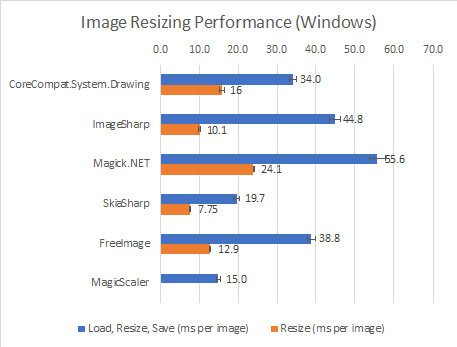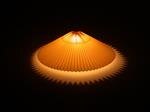Image processing, and in particular image resizing, is a common requirement for web applications. As such, I wanted to paint a panorama of the options that exist for .NET Core to process images. For each option, I’ll give a code sample for image resizing, and I’ll outline interesting features. I’ll conclude with a comparison of the performance of the libraries, in terms of speed, size, and quality of the output.
CoreCompat.System.Drawing
If you have existing code relying on System.Drawing, using this library is clearly your fastest path to .NET Core and cross-platform bliss: the performance and quality are fine, and the API is exactly the same. The built-in System.Drawing APIs are the easiest way to process images with .NET Framework, but they rely on the GDI+ features from Windows, which are not included in .NET Core, and are a client technology that was never designed for multi-threaded server environments. There are locking issues that may make this solution unsuitable for your applications.
CoreCompat.System.Drawing is a .NET Core port of the Mono implementation of System.Drawing. Like System.Drawing in .NET Framework and in Mono, CoreCompat.System.Drawing also relies on GDI+ on Windows. Caution is therefore advised, for the same reasons.
Also be careful when using the library cross-platform, to include the runtime.osx.10.10-x64.CoreCompat.System.Drawing and / or runtime.linux-x64.CoreCompat.System.Drawing packages.
- Nuget: CoreCompat.System.Drawing, runtime.osx.10.10-x64.CoreCompat.System.Drawing, and runtime.linux-x64.CoreCompat.System.Drawing
- GitHub: CoreCompat/CoreCompat
ImageSharp
ImageSharp is a brand new, pure managed code, and cross-platform image processing library. Its performance is not as good as that of libraries relying on native OS-specific dependencies, but it remains very reasonable. Its only dependency is .NET itself, which makes it extremely portable: there is no additional package to install, just reference ImageSharp itself, and you’re done.
If you decide to use ImageSharp, don’t include the package that shows on NuGet: that’s going to be an empty placeholder until the first official release of ImageSharp ships. For the moment, you need to get a nightly build from a MyGet feed. This can be done by adding the following NuGet.config to the root directory of the project:
Resizing an image with ImageSharp is very simple.
For a new codebase, the library is surprisingly complete. It includes all the filters you’d expect to treat images, and even includes very comprehensive support for reading and writing EXIF tags (that code is shared with Magick.NET):
Note that the latest builds of ImageSharp are more modular than they used to, and if you’re going to use image formats such as Jpeg, or image processing capabilities such as Resize, you need to import additional packages in addition to the core ImageSharp package (respectively ImageSharp.Processing and ImageSharp.Formats.Jpeg).
- MyGet: ImageSharp
- GitHub: JimBobSquarePants/ImageSharp
Magick.NET
Magick.NET is the .NET wrapper for the popular ImageMagick library. ImageMagick is an open-source, cross-platform library that focuses on image quality, and on offering a very wide choice of supported image formats. It also has the same support for EXIF as ImageSharp.
The .NET Core build of Magick.NET currently only supports Windows. The author of the library, Dirk Lemstra is looking for help with converting build scripts for the native ImageMagick dependency, so if you have some expertise building native libraries on Mac or Linux, this is a great opportunity to help an awesome project.
Magick.NET has the best image quality of all the libraries discussed in this post, as you can see in the samples below, and it performs relatively well. It also has a very complete API, and the best support for exotic file formats.
- NuGet: Magick.NET.Core-Q8
- Github: dlemstra/Magick.NET
SkiaSharp
SkiaSharp is the .NET wrapper for Google’s Skia cross-platform 2D graphics library, that is maintained by the Xamarin team. SkiaSharp is now compatible with .NET Core, and is extremely fast. As it relies on native libraries, its installation can be tricky, but I was able to make it work easily on Windows and macOS. Linux is currently more challenging, as it’s necessary to build some native libraries from code, but the team is working on ironing out those speedbumps, so SkiaSharp should soon be a very interesting option.
- NuGet: SkiaSharp
- GitHub: mono/SkiaSharp
FreeImage-dotnet-core
This library is to the native FreeImage library what Magick.NET is to ImageMagick: a .NET Core wrapper. It offers a nice choice of image formats, good performance, and good visual quality. Cross-platform support at this point is not perfect however, as I was unable to save images to disk on Linux and macOS. Hopefully that is fixed soon.
- NuGet: FreeImage dotnet core
- GitHub: matgr1/FreeImage-dotnet-core
MagicScaler
MagicScaler is a Windows-only library that relies on Windows Image Components (WIC) for handling the images, but applies its own algorithms for very high quality resampling. It’s not a general purpose 2D library, but one that focuses exclusively on image resizing. As you can see in the gallery below, the results are impressive: the library is extremely fast, and achieves unparalleled quality. The lack of cross-platform support is going to be a showstopper to many applications, but if you can afford to run on Windows only, and only need image resizing, this is a superb choice.
- NuGet: PhotoSauce.MagicScaler
- Blog post: Introducing MagicScaler
Performance comparison
The first benchmark loads, resizes, and saves images on disk as Jpegs with a a quality of 75. I used 12 images with a good variety of subjects, and details that are not too easy to resize, so that defects are easy to spot. The images are roughly one megapixel JPEGs, except for one of the images that is a little smaller. Your mileage may vary, depending on what type of image you need to work with. I’d recommend you try to reproduce these results with a sample of images that corresponds to your own use case.
For the second benchmark, an empty megapixel image is resized to a 150 pixel wide thumbnail, without disk access.
The benchmarks use .NET Core 1.0.3 (the latest LTS at this date) for CoreCompat.System.Drawing, ImageSharp, and Magick.NET, and Mono 4.6.2 for SkiaSharp.
I ran the benchmarks on Windows on a HP Z420 workstation with a quad-core Xeon E5-1620 processor, 16GB of RAM, and the built-in Radeon GPU. For Linux, the results are for the same machine as Windows, but in a 4GB VM, so lower performance does not mean anything regarding Windows vs. Linux performance, and only library to library comparison should be considered meaningful. The macOS numbers are on an iMac with a 1.4GHz Core i5 processor, 8GB of RAM, and the built-in Intel HD Graphics 5000 GPU, running macOS Sierra.
Results are going to vary substantially depending on hardware: usage and performance of the GPU and of SIMD depends on both what’s available on the machine, and on the usage the library is making of it. Developers wanting to get maximum performance should further experiment. I should mention that I had to disable OpenCL on Magick.NET (OpenCL.IsEnabled = false;), as I was getting substantially worse performance with it enabled on that workstation than on my laptop.

| Library | Load, resize, save (ms per image) | Resize (ms per image) |
|---|---|---|
| CoreCompat.System.Drawing | 34 ± 1 | 16.0 ± 0.6 |
| ImageSharp | 45 ± 1 | 10.1 ± 0.2 |
| Magick.NET | 56 ± 2 | 24.1 ± 0.3 |
| SkiaSharp | 20 ± 1 | 7.8 ± 0.1 |
| FreeImage | 39 ± 1 | 12.9 ± 0.1 |
| MagicScaler | 20 ± 1 | n/a |
For both metrics, lower is better.

| Library | Load, resize, save (ms per image) | Resize (ms per image) |
|---|---|---|
| CoreCompat.System.Drawing | 93 ± 1 | 71.5 ± 0.3 |
| ImageSharp | 70.3 ± 0.3 | 27.6 ± 0.2 |
| SkiaSharp | 15.9 ± 0.1 | 7.6 ± 0.1 |
| FreeImage | n/a | 12.8 ± 0.1 |
For both metrics, lower is better.

| Library | Load, resize, save (ms per image) | Resize (ms per image) |
|---|---|---|
| CoreCompat.System.Drawing | 114 ± 5 | 92 ± 1 |
| ImageSharp | 384 ± 5 | 128 ± 1 |
| FreeImage | n/a | 29.7 ± 2 |
For both metrics, lower is better.

| Library | File Size (average kB per image) |
|---|---|
| CoreCompat.System.Drawing | 4.0 |
| ImageSharp | 4.0 |
| Magick.NET | 4.2 |
| SkiaSharp | 3.6 |
| FreeImage | 3.6 |
| MagicScaler | 4.3 |
Lower is better. Note that file size is affected by the quality of the subsampling that’s being performed, so size comparisons should take into account the visual quality of the end result.
Quality comparison
Here are the resized images. As you can see, the quality varies a lot from one image to the next, and between libraries. Some images show dramatic differences in sharpness, and some moiré effects can be seen in places. You should make a choice based on the constraints of your project, and on the performance vs. quality trade-offs you’re willing to make.
| CoreCompat. System.Drawing | ImageSharp | Magick.NET | SkiaSharp | FreeImage | MagicScaler |
|---|---|---|---|---|---|
 |
 |
 |
 |
 |
 |
 |
 |
 |
 |
 |
 |
 |
 |
 |
 |
 |
 |
 |
 |
 |
 |
 |
 |
 |
 |
 |
 |
 |
 |
 |
 |
 |
 |
 |
 |
 |
 |
 |
 |
 |
 |
 |
 |
 |
 |
 |
 |
 |
 |
 |
 |
 |
 |
 |
 |
 |
 |
 |
 |
 |
 |
 |
 |
 |
 |
 |
 |
 |
 |
 |
 |
Conclusions
There is today a good choice of libraries for image processing on .NET Core, that can fit different requirements, with even more great choices coming in the near future.
If performance is your priority, CoreCompat.System.Drawing is a good choice today if the possible lock issues in Windows server scenarios are not a showstopper for your application. SkiaSharp, when Linux setup issues are resolved, will be a fantastic choice that offers performance without compromising quality.
If quality is your top-priority, and you can run on Windows only, MagicScaler is fantastic, without a performance compromise.
If file type support is your priority, Magick.NET is the winner. Cross-platform support is not quite there yet, however, but you can help.
Finally, the only pure managed code library available at this point, ImageSharp, is an excellent choice. Its performance is close to that of Magick.NET, and the fact that it has no native dependencies means that the library is guaranteed to work everywhere .NET Core works. The library is still in alpha, and significant performance improvements are in store, notably with future usage of Span<T> and ref returns.
Acknowledgements
All four libraries in this post are open-source, and only exist thanks to the talent and generosity of their authors, contributors and maintainers. In particular,
- Frederik Carlier wrote
CoreCompat.System.Drawing. - James Jackson South wrote ImageSharp. James was extremely helpful while I was preparing this post, and even contributed sample code.
- Dirk Lemstra wrote Magick.NET. Dirk was also super-patient and nice, and helped me fix some performance issues I had on my benchmark machine. He also fixed my sample code.
- Matthew Leibowitz maintains SkiaSharp.
- Clinton Ingram wrote MagicScaler.
Sample code
My sample code can be found on GitHub. The repository includes the sample images I’ve been using in this post.
UPDATE 1/20/2017 11:09AM PST: updating ImageSharp to the latest daily build (1.0.0-alpha1-00053) considerably improved output quality.
UPDATE 2/14/2017: updated all libraries to their latest version, ran SkiaSharp on .NET Core instead of Mono, updated sample code for better quality, added FreeImage and MagicScaler libraries, re-ran all benchmarks.
UPDATE 2/16/2017: fixed an anomaly in Magick.NET Windows performance.


0 comments